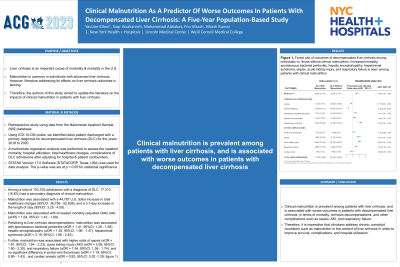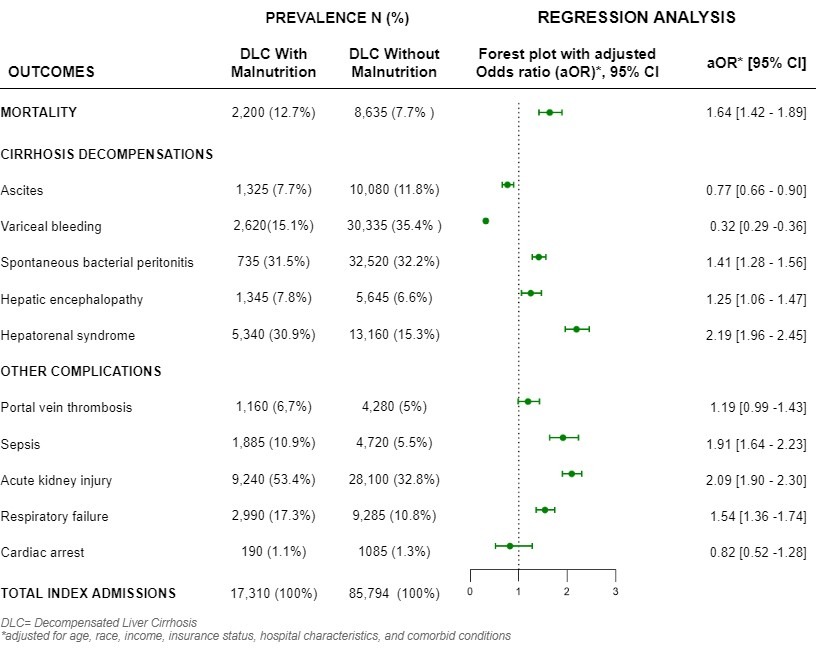Sunday Poster Session
Category: Liver
P0994 - Clinical Malnutrition Is Associated With Worse Outcomes in Patients With Decompensated Liver Cirrhosis: A Five-Year Population-Based Study
Sunday, October 22, 2023
3:30 PM - 7:00 PM PT
Location: Exhibit Hall

Has Audio
- YK
Yassine Kilani, MD
Lincoln Medical Center
New York, NY
Presenting Author(s)
Yassine Kilani, MD1, Mohammad Aldiabat, MD2, Saqr Alsakarneh, MD3, Priscila Castro Puello, MD1, Iqra Arshad, MD1, Vikash Kumar, MD4, Fnu Vikash, MD5
1Lincoln Medical Center, New York, NY; 2NYU Langone Health, New York, NY; 3University of Missouri Kansas City, Kansas City, KS; 4Brooklyn Hospital Center, Brooklyn, NY; 5Jacobi Medical Center, Albert Einstein College of Medicine, Bronx, NY
Introduction: Liver cirrhosis is an important cause of morbidity & mortality in the U.S. Malnutrition is common in individuals with advanced liver cirrhosis, however, literature addressing its effects on liver cirrhosis outcomes is lacking. Therefore, the authors of this study aimed to update the literature on this.
Methods: This is a retrospective longitudinal study of individuals admitted with decompensated liver cirrhosis (DLC). Using weighted data from the Nationwide Inpatient Sample (NIS) database from 2016 to 2020, we assessed DLC outcomes (mortality, hospital utilization, total healthcare charges, complications) in patients with and without clinical malnutrition. Baseline characteristics were analyzed using T-test and Chi-Square, and a multivariate regression analysis was used to estimate outcomes for patients with clinical malnutrition. Data analysis was performed using STATA® Version 17.0/SE Software, with statistical significance set at p < 0.05.
Results: Among a total of 103,105 admissions with a primary diagnosis of DLC, 17,310 (16.8%) had a secondary diagnosis of clinical malnutrition. Clinical malnutrition was associated with a 44,787 U.S. dollar increase in total healthcare charges (95%CI: 36,736 - 52,838), and a 3.7-day increase in the length of stay (95%CI: 3.25 - 4.09). Pertaining to liver cirrhosis decompensations, malnutrition was associated with increased mortality (adjusted Odds ratio (aOR) = 1.64, 95%CI: 1.42 - 1.89), spontaneous bacterial peritonitis (aOR = 1.41, 95%CI: 1.28 - 1.56), hepatic encephalopathy (aOR = 1.25, 95%CI: 1.06 - 1.47), and hepatorenal syndrome (aOR = 2.19, 95%CI: 1.96 - 2.45). Further, malnutrition was associated with higher risks of sepsis (aOR = 1.91, 95%CI: 1.64 - 2.23), acute kidney injury (AKI) (aOR = 2.09, 95%CI: 1.90 - 2.30), and respiratory failure (aOR = 1.54, 95%CI: 1.36 - 1.74) (figure 1).
Discussion: Clinical malnutrition is prevalent among patients with liver cirrhosis, and is associated with worse outcomes in patients with decompensated liver cirrhosis, in terms of mortality, cirrhosis decompensations, and other complications such as sepsis, AKI, and respiratory failure. Therefore, it is imperative that clinicians address chronic comorbid conditions such as malnutrition in the context of liver cirrhosis in order to improve survival, complications, and hospital utilization.

Disclosures:
Yassine Kilani, MD1, Mohammad Aldiabat, MD2, Saqr Alsakarneh, MD3, Priscila Castro Puello, MD1, Iqra Arshad, MD1, Vikash Kumar, MD4, Fnu Vikash, MD5. P0994 - Clinical Malnutrition Is Associated With Worse Outcomes in Patients With Decompensated Liver Cirrhosis: A Five-Year Population-Based Study, ACG 2023 Annual Scientific Meeting Abstracts. Vancouver, BC, Canada: American College of Gastroenterology.
1Lincoln Medical Center, New York, NY; 2NYU Langone Health, New York, NY; 3University of Missouri Kansas City, Kansas City, KS; 4Brooklyn Hospital Center, Brooklyn, NY; 5Jacobi Medical Center, Albert Einstein College of Medicine, Bronx, NY
Introduction: Liver cirrhosis is an important cause of morbidity & mortality in the U.S. Malnutrition is common in individuals with advanced liver cirrhosis, however, literature addressing its effects on liver cirrhosis outcomes is lacking. Therefore, the authors of this study aimed to update the literature on this.
Methods: This is a retrospective longitudinal study of individuals admitted with decompensated liver cirrhosis (DLC). Using weighted data from the Nationwide Inpatient Sample (NIS) database from 2016 to 2020, we assessed DLC outcomes (mortality, hospital utilization, total healthcare charges, complications) in patients with and without clinical malnutrition. Baseline characteristics were analyzed using T-test and Chi-Square, and a multivariate regression analysis was used to estimate outcomes for patients with clinical malnutrition. Data analysis was performed using STATA® Version 17.0/SE Software, with statistical significance set at p < 0.05.
Results: Among a total of 103,105 admissions with a primary diagnosis of DLC, 17,310 (16.8%) had a secondary diagnosis of clinical malnutrition. Clinical malnutrition was associated with a 44,787 U.S. dollar increase in total healthcare charges (95%CI: 36,736 - 52,838), and a 3.7-day increase in the length of stay (95%CI: 3.25 - 4.09). Pertaining to liver cirrhosis decompensations, malnutrition was associated with increased mortality (adjusted Odds ratio (aOR) = 1.64, 95%CI: 1.42 - 1.89), spontaneous bacterial peritonitis (aOR = 1.41, 95%CI: 1.28 - 1.56), hepatic encephalopathy (aOR = 1.25, 95%CI: 1.06 - 1.47), and hepatorenal syndrome (aOR = 2.19, 95%CI: 1.96 - 2.45). Further, malnutrition was associated with higher risks of sepsis (aOR = 1.91, 95%CI: 1.64 - 2.23), acute kidney injury (AKI) (aOR = 2.09, 95%CI: 1.90 - 2.30), and respiratory failure (aOR = 1.54, 95%CI: 1.36 - 1.74) (figure 1).
Discussion: Clinical malnutrition is prevalent among patients with liver cirrhosis, and is associated with worse outcomes in patients with decompensated liver cirrhosis, in terms of mortality, cirrhosis decompensations, and other complications such as sepsis, AKI, and respiratory failure. Therefore, it is imperative that clinicians address chronic comorbid conditions such as malnutrition in the context of liver cirrhosis in order to improve survival, complications, and hospital utilization.

Figure: Figure 1. Forest plot of outcomes of decompensated liver cirrhosis among individuals vs. those without clinical malnutrition. Increased mortality, spontaneous bacterial peritonitis, hepatic encephalopathy, hepatorenal syndrome, sepsis, acute kidney injury, and respiratory failure is seen among patients with clinical malnutrition
Disclosures:
Yassine Kilani indicated no relevant financial relationships.
Mohammad Aldiabat indicated no relevant financial relationships.
Saqr Alsakarneh indicated no relevant financial relationships.
Priscila Castro Puello indicated no relevant financial relationships.
Iqra Arshad indicated no relevant financial relationships.
Vikash Kumar indicated no relevant financial relationships.
Fnu Vikash indicated no relevant financial relationships.
Yassine Kilani, MD1, Mohammad Aldiabat, MD2, Saqr Alsakarneh, MD3, Priscila Castro Puello, MD1, Iqra Arshad, MD1, Vikash Kumar, MD4, Fnu Vikash, MD5. P0994 - Clinical Malnutrition Is Associated With Worse Outcomes in Patients With Decompensated Liver Cirrhosis: A Five-Year Population-Based Study, ACG 2023 Annual Scientific Meeting Abstracts. Vancouver, BC, Canada: American College of Gastroenterology.
